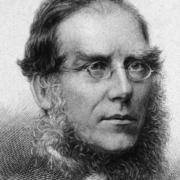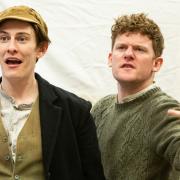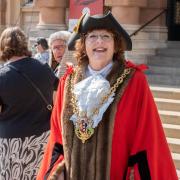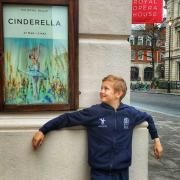In corners everywhere are quiet reminders of how our county helped to defend the country during wartime - with a little help from some US friends. Maggie Aggiss discovers one of them.
During the summer, I was just taking a leisurely bike ride around the Eye area. With no actual route in mind, I headed through the quiet and pleasant village of Redlingfield. As I was rounding a corner on a little lane, I was surprised to come across a very smart granite memorial on the edge of a wheat field. I almost cycled straight past it as it was shaded by a spinney of trees. Had I been in the car I might have missed it. I had to stop to investigate.
I was about to read the inscription on the memorial, but the accompanying information board showing the faces of 10 young men caught my attention. Here were the images of the crew of a B-17 Flying Fortress bomber, tragically killed in an horrific accident as they took off from the nearby United States Army Air Force base at Horham airfield, shortly after 8.30am on November 19, 1943.

Of course, there were hundreds of similar accidents during the Second World War, but what really struck me about this memorial wasn’t just the photos but the personal details of this crew. It included the jobs they did back in America before they found themselves thousands of miles from home, fighting a world war in a country that most of them had only heard of, only to lose their lives in a wood, by a farm field, in the middle of nowhere.
Second Lt Warren, single, was a doorman from Missouri; Joseph Spicer, single, a printer from Illinois; Gail A Richmond, single, a tool worker from Pennsylvania; S/Sgt Kenneth Cosby, a clerk from Ohio; S/Sgt Gordon Sorensen, married, chauffeur from Michigan, and so it goes on. Their average age was 23.
READ: Unexplained mystery of 200 skeletons beneath Burrow Hill
East Anglia had the largest population of American bases in the UK. Many aircraft, whether bomber or fighter, returning from a mission would have been crippled by air or ground fire, and while some managed to limp home, others crashed before reaching their home base.
Taking off for a mission brought a different kind of danger. Bombers would be carrying their full bomb load. As the USAAF carried out their bombing missions during daylight hours, they would take off early in the morning. In winter this meant that aircraft were prone to icing up on take-off as air temperatures dropped. Mechanical failures and snap decisions were also common.
Just three days before the fateful Redlingfield crash, co-pilot 2nd Lt Warren Strawn sent a letter home to his parents describing a recent mission during which all four engines of their aircraft had failed, forcing the pilot to ditch in the North Sea.
With a touch of humour and some forced bravado - probably to spare his parents too much anxiety - Strawn wrote: “We only floated in the sea for ten hours, which is not at all bad...” He finished the letter on a light and romantic note, talking about attending his first formal dance of the winter season. “I took a very pretty little English girl to the dance; she is the prettiest thing I’ve seen since I left the US, and I’m going to see her again some time.”

Most people in Suffolk lived within 10 miles of an American air base and had to learn to live with all the things that went with that situation in wartime.
Jeeps, trucks and bicycles were whizzing around little lanes, aircraft were an almost constant presence in the skies above, and while air raids were an abiding fear, air accidents were a persistent danger here in Suffolk, not only for air crews but for local communities too, particularly if you happened to live and work close to an airfield.
Colonel Harry Conley, Sqn Commander of the 344th Bomb Squadron, Horham, shared his memories of the Redlingfield accident. “As [Lieutenant Kenneth B] Rongstad's plane lumbered along, gaining speed as it neared the end of the runway, it barely lifted off. It started its bank to the left, but it was still too close to the ground. The plane stalled, it’s left wing hit a field. The plane spun around and crashed, it started burning right away.
"I ran and jumped into my jeep and drove as fast as I could over to the plane, which was now burning furiously and igniting ammunition like very loud popcorn going off inside. I was less than 50 yards away when - whoom! The whole thing exploded big time! It literally blew me flat back on my backside.
There was a farmhouse about 40 yards from the crash. Inside it was the farmer’s wife, eight months along in her pregnancy, along with her two-year-old daughter. Thank God neither she nor her daughter were hurt, and the severe trauma did not disturb her pregnancy.”
The farmhouse was Green Farm Redlingfield, and the ‘farmers wife’ was Ruby Gooderham. Ruby recalled: “Victor had a feeling that morning that something would happen, but he went off to work as usual, as the planes roared overhead. It was a frosty morning, very, very cold. The plane came down not far from our house. I was thrown across the room by the explosion, and the ceiling came down on top of us.
"As luck would have it, the beams in the cottage held. Windows and doors fell in as parts of the burning plane fell. I picked up my daughter Anne and prayed to God to help us. I went to put her in a pram, but it was filled with broken glass. I pulled down a curtain to keep us warm as metal fell like rain around us. A neighbour told me to get behind a muck heap as I could not stoop due to me being heavily pregnant.”

As personnel from the base arrived on the scene, the bombs on the aircraft continuing to explode sporadically, they headed straight to the farm and tried to comfort Ruby and Anne, working to shield them from burning fragments. A doctor from the airfield, ‘Doc Imes’, took them to the base hospital to get them checked. All was well, so he took Ruby to her mother's home in Redlingfield.
The village blacksmith, Alfred Coe, was also a special police constable and was the first local person on the scene. He was blown off his bicycle by one of the first blasts but he still managed to help and later received a commendation for his actions. He also made a strange observation – a bottle of milk that was on a bench when the plane crashed was still standing, untouched, when the entire event was over.

Ruby concluded: “My husband, Victor, was very glad to find us alive. The whole crew perished in the crash – all 10 of them. We stayed with my parents until our son was born in December. Our home was destroyed, but our lives were saved.” With concern for the long-term effects on the Gooderham family, Col Conley wrote: “The American Army compensated Ruby for her physical losses, but I doubt that she and her husband ever wanted to live that close to an airfield again.”
SUBSCRIBE: Get Suffolk magazine every month and read more fascinating stories about the county
Many of us pass the sites of Second World War air crash sites without realising it, whether they be fields, woods or roads. It would be impossible for the site of every crash site to have a memorial. But all around the Suffolk countryside, fragments of crashed aircraft turn up with the plough, and what remains of the former US bases are there to remind us, with their cracked and weed ridden concrete runways and tracks, and the odd ivy-covered hut.
As poet and First World War soldier Rupert Brook wrote in The Soldier:
If I should die, think only this of me:
That there’s some corner of a foreign field
That is forever England.
Maybe there are corners of the ‘foreign fields’ of Suffolk that will be forever America.
With sincere thanks to The Red Feather Club Museum members (95th Bomb Group Heritage Association) especially Beverley Abbott, of Redlingfield.



























